Mechanics were the first major changes introduced into World of Warcraft in the new system, but they weren’t the only ones. While many players were forcing themselves to reexamine how their classes played, others were trying to wrap their heads around what exactly had happened to their stats, spec, gear and even raiding itself.
Several popular stats made an exit in 4.0.1, which forced many players to either re-gem or re-enchant their characters, or rework their gear entirely. Suddenly, certain gear options were no longer so lucrative. Others became much more effective. One great example is the popular melee drop Deathspeaker Zealot’s Helm. It’s favored because of it’s 68 haste stat over the purchasable set item. the purchasable item uses a different stat, armor penetration. With the reworking, the drop helm now lags behind its alternative because the Armor Penetration bonus of 80 was switched to haste. Both items have identical stat bonuses, but one offers both haste and a set bonus.
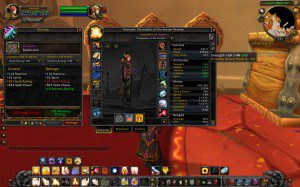
In addition, certain other stats were changed from core stats to secondary stats, and thus were now eligible for a brand new process known as reforging. Reforging is where specific bonus stats could be lowered in favor of adding an entirely new value to the gear. Reforging is supposed to allow a new, unprecedented level of customization to the game. Complementing such classic tools as enchantment and gemming, which itself was added in the Burning Crusade expansion for much the same reason.
The eliminated stats in 4.0.1 include defense, MP5 (a system of mana-regeneration focused on mana regained per 5 seconds), spirit (which has been changed to a secondary stat), and armor penetration (which was folded into either Critical strike or haste, depending on the gear).
In addition, a new stat known as mastery has appeared in the new patch. Mastery is related to the idea of talent mastery, which becomes available after the character has attained the maximum talent on their dedicated tree. Mastery rating adds to the effectiveness of the talent specific skill for example : holy paladins casting a defensive shield around targets they heal, frost death knights increase their frost damage, and retribution paladins see their mastery proc. Mastery proc allows for a free strike at maximum holy power without expending current charges, and light up more frequently. As of now, few classes have a definite need for this skill, which appears on no current gear and must be reforged into it. When Cataclysm is released, it’s necessity will become more and more apparent.
Talent Changes
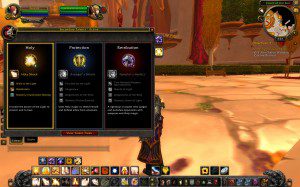
The other big change Blizzard implemented was eliminating the old talent system in favor of a new, more streamlined process. Under the old game, talent points were gained each level after 10, and could be spent on any number of talents in the player’s three trees. This lead to a lot of experimenting with hybrid trees on the one side, and a whole glut of unnecessary talents on the other. Many of said talents added passive bonuses to stats, or were taken simply to have enough points to unlock the next level of the tree. Many players complained that much of these talents needed to be reworked or thrown out altogether.
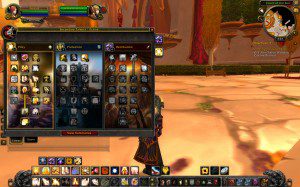
Under the new system, players must choose at level 10 a specific tree to specialize in, and must remain on that tree until they have mastered it (through the purchasing of the 31 point talent) before they are allowed to move on. Talents are not gained every other level, instead of gaining every level. The days of hybrid trees have officially been closed. In their place is the mastery ability (mentioned above) that adds a bonus or power to their skills from that tree. It can be raised and lowered like any other secondary stat. Many familiar talents remain on the trees, but they have been reworked in most cases. Some of the generic talents are outright gone. Many a ret paladin discovered this the hard way when they logged in and saw their critical strike chance drop around 10%, due to the elimination of two talents that gave it a serious buff.
Dual specialization remains unchanged in 4.0.1. Glyphs are still there, but this time around they are learned permanently instead of being a one-time use. The glyph tree has been expanded to include 9 slots at max level, and glyphs can be replaced through the application of an erase reagent.
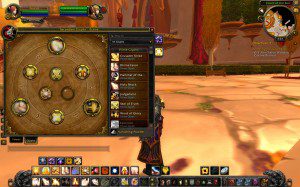
Gear Changes
In the old patch, gear grinding was made easier than ever before through the implementation of the badge system. Rather than running through raid after raid looking for gear, now Heroic Instance Dungeon bosses dropped badges. They could be stockpiled and spent on tier 9 gear in preparation for Icecrown Citadel raids. Frost badges, a more powerful version of the badges, could also be acquired through raid content. This could then be spent on even more powerful gear before the final raid was even undertaken. For example, I had 2 pieces of tier 10 before I ever saw the Citadel. This system, which I believe was introduced in the Burning Crusade, made gearing up for raids a far less painful process. It was still repetitive in nature, but this time the rewards were much more obtainable than random drops from bosses.
In 4.0.1, the badge system has been done away with entirely, and was replaced with a point-based system that uses justice points to purchase gear. This essentially folded the tier 9 and 10 badges into base currency. Now players can run endless heroics in order to grind enough points to purchase the upper level tier 10 gear. To give an example of the new ease of gearing : an 80, the average random heroic has 4 bosses. Each worth around 16 justice points apiece. For completing the random itself, the player is rewarded an additional 24 justice points. Which means the average heroic random will net the player around 88 justice points. Adjust this total accordingly. Raid bosses provide 24 points apiece, and weekly raids around 150. Now compare to cost: tier 10 gear sells for 695-1100 points for core pieces, 300-500 for accessories. Much of the tier 1o gear can now be purchased right off the bat. This gives fresh 80s a chance to gear up and raid within a few days dedicated grinding, as opposed to the older 2 frost-a-day grind.
This impact of unified currency is already showing in dungeons and raids. The Vault of Archavon, previously only run for Frost badges, is now being fully cleared again. And heroic instances with optional bosses are now being done the same. In the weeks since patch day, I myself have managed to grind out 4 pieces of level 264 tier 10 gear. The gear is equivalent to an Icecrown Citadel 25 raid drop, all within about 3 days. Not 3 days per piece, just 3 days total.
This gear race is definitely in anticipation of the Cataclysm launch, and it will all be obsolete by level 83. There is still good appeal at seeing nice, shiny tier 10 gear on your toon.
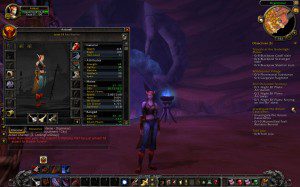
Raiding Changes
The biggest change to the raiding system in 4.0.1 is the new flexible raid lockout. This saves a character to a specific boss, rather than to a raid. Many raiders complained that if end game raids fell apart after the first 3-4 bosses, then they would be locked out for the week. This is especially a concern for people who use PUGs (Pick-Up-Groups, people not in the same guild who are brought in to fill a role as needed), and would have that one chance to run the raid. Under the new system, the player’s raid lock is linked to the bosses they defeat. If one player drops the first 4 bosses and the raid dies, he may easily join another raid later in the week. Now he would be picking up from the 5th boss onwards instead. Later in the game, this will apply to all raids as well. As gear in 10 and 25 man raids were be uniformed, and characters may then run raids with many different group sizes at different times.
A lot to digest, isn’t it? It took me the better part of two weeks to get it all down as I relearned my character’s abilities, and adjusted for new play styles. As a casual player, I was hit hard by a few of the patch changes. Especially the ones to my main character, a paladin.
But how did these changes impact the style of specific classes? Well, as I said I have just two toons, but I already have had to make adjustments to them. What follows will be my impressions on those two classes, and how the new system has impacted them.

